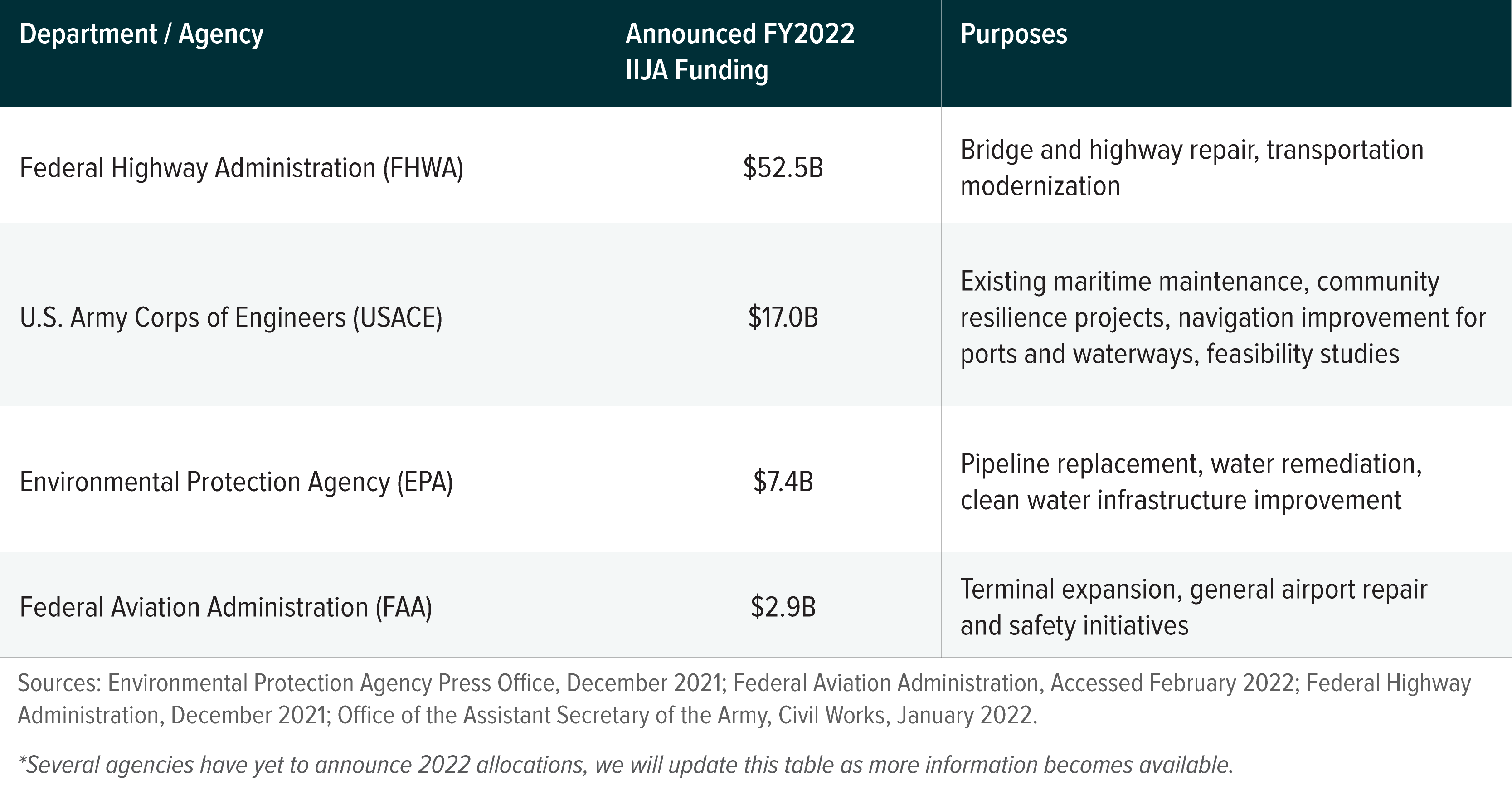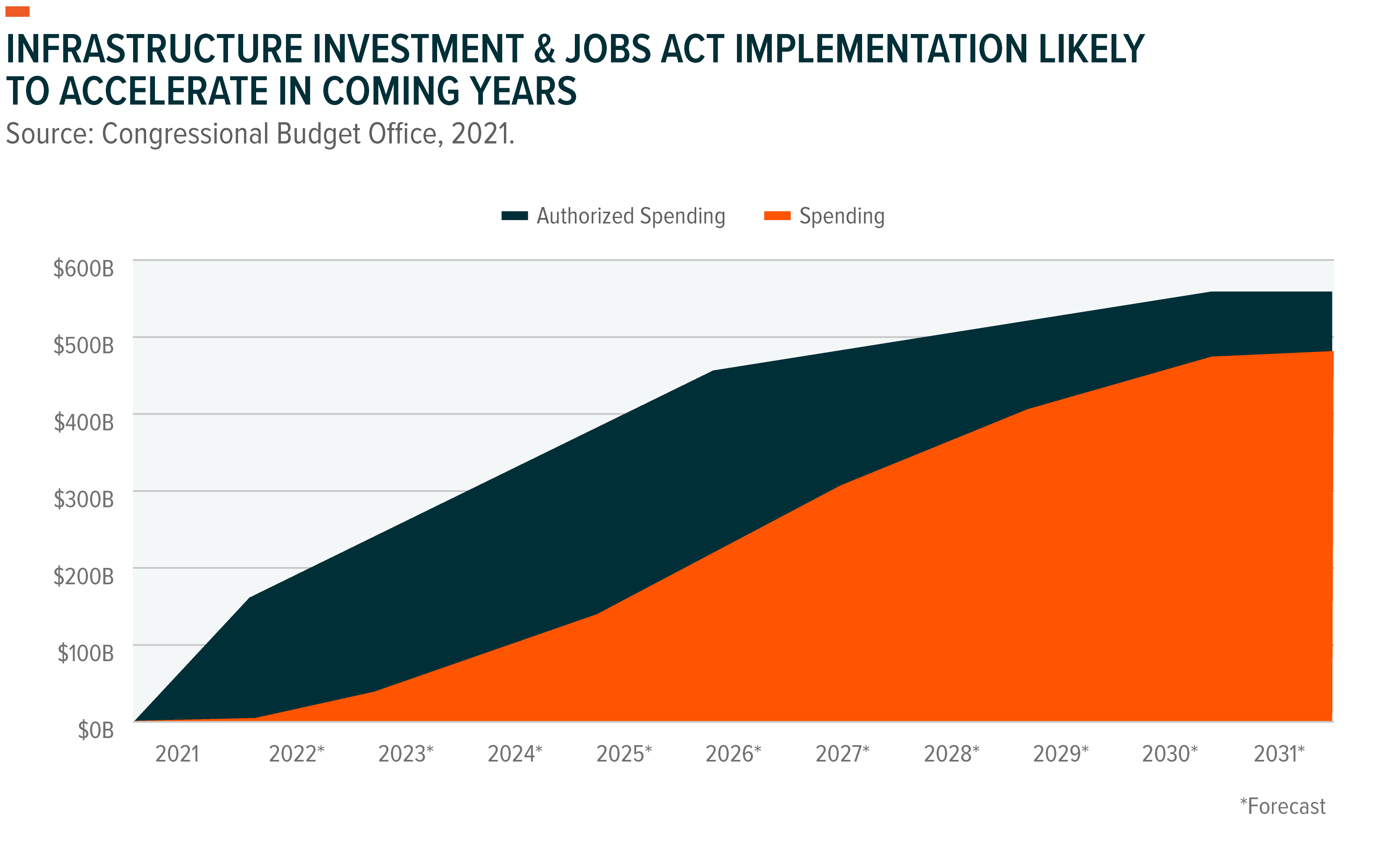What’s Next for Infrastructure Spending?
The passage of the Infrastructure Investment and Jobs Act (IIJA), which was signed into law in November 2021, is already starting to drive funding to some of America’s most important and chronically underfunded infrastructure projects. The $1.2 trillion bill includes much-needed funding for traditional and next-generation infrastructure areas such as roads and bridges, electrification, rail, broadband access and clean water. For a thorough breakdown of the bill, please check out our piece on Congress passing the IIJA. Most of the IIJA’s impact will play out over decades, but with spending already underway and key plans formulating, we highlight a few projects poised to benefit in the near term.
Key Takeaways
Federal agencies have announced large infrastructure spending tranches for Fiscal Year (FY) 2022, with the largest allocation declared so far coming from the Federal Highway Administration at $52.5 billion.1
Projects moving forward due to the IIJA include the long-delayed $10 billion Hudson River Tunnel project between New York and New Jersey, and the Soo Locks project in Michigan.2
IIJA funding will spread gradually, with roughly 50% of authorised funding likely disbursed by 2026, which should give infrastructure-related companies time to ramp up capacity.3
Infrastructure Spending Categories to Watch in 2022
A combination of federal logistics and urgency will determine the extent to which programs receive IIJA funding in 2022. The bill tasks cabinet-level departments such as the Department of Transportation (DOT) and the Department of Energy (DOE) with distributing apportionments to states. Within these departments, several agencies announced allocations from the IIJA that will be available in 2022:

Clean water initiatives such as pipe replacement could be among the first projects to receive IIJA funding tranches because longstanding programs exist to deliver this kind of investment. For example, the Drinking and Clean Water State Revolving Funds (DWSRF and CWSRF), the main mechanisms by which the EPA will distribute funding to the state level, originated in 1996 and 1987, respectively. The bill dramatically increases funding levels for these programs, but the framework to distribute resources to the state level is largely in place.4 Conversely, the DOE’s many next-generation infrastructure investments may take longer to mobilise, as 56 of the department’s 69 IIJA-funded projects originate with the bill.5
Another factor likely to impact timing is whether a program provides discretionary or formula grant funding. Discretionary funding requires states to create proposals and essentially compete for additional allocations, whereas formula grants are automatically distributed to states based on a statutory methodology. The extra steps associated with competitive funding add a layer of red tape, and thus can delay implementation. However, formula grant initiatives such as the Airport Infrastructure Grant and Bridge Formula programs can roll out funding as soon as this year.6 Overall, about 60% of IIJA state-level funding is formula-based.7
The federal government is also pushing funds toward projects that expand port capacity in a bid to counter recent supply chain bottlenecks related to the pandemic. As of January 2022, a record 109 cargo ships were waiting to enter the Port of Los Angeles, a testament to ongoing supply chain challenges.8 Although current port expansion projects are unlikely to be completed in time to alleviate the current situation, the Biden administration is making a point of distributing these funds as soon as possible in an effort to protect against future supply chain issues. As a result, the DOT awarded $241M for various port expansion projects last December, barely a month after President Biden signed the IIJA into law.9 In 2022, the U.S. Army Corps of Engineers (USACE) will follow this allocation up by dedicating almost $4 billion toward coastal port and inland waterway improvement projects.10
IIJA Funding Already Making a Difference for Projects
Some long-stalled projects are finally moving forward due to the IIJA, while other projects could be poised to advance to their next stages on schedule.
- Gateway Program (NY & NJ): Projects to repair and expand the Hudson River Tunnel that connects New York City with New Jersey will move forward due to $8 billion in IIJA funding for the broader Gateway Program for rail investment.11 The 111-year-old tunnel transported 200,000 people daily pre-pandemic and still has damages dating back to Hurricane Sandy in 2012.12 The project is in its permitting stages, but it could begin construction as soon as the summer of 2023.13
- Soo Locks Project (MI): The IIJA provides $479M to fully fund completion of the long-delayed Soo Locks project in Michigan, first authorised in 1986.14 This project will provide capacity improvements and redundancy options for the Soo Locks, a shipping complex that transports around 10,000 cargo ships annually between Lake Superior and the lower Great Lakes. The project will likely award a contract in Spring 2022 with a targeted completion in 2030.15
- Houston Ship Channel Project 11 (TX): The USACE will award about $142M to keep an ongoing $1 billion project to widen and deepen a segment of the Houston Ship Channel on schedule.16 The Port of Houston is a critical logistical center that requires expansion due to increasing container volumes. The project, which involves partnerships between engineering firms Gahagan & Bryant and AECOM as well as the USACE, recently awarded its first dredging contract and could reach completion by 2025.17
- Denver International Airport Expansion (CO): In September 2021, the Denver City Council awarded Jacobs Engineering and AECOM contracts for design consulting and project management on a new runway for the Denver International Airport.18 The Airport Infrastructure Grant program distributes $59 million to the Denver International Airport in 2022, funding that could accelerate progress on this planned expansion.19 Currently the project is in its environmental review stage with a 2028 delivery target.20
- Fern Hollow Bridge Replacement (PA): In January 2022, the Fern Hollow Bridge made headlines when it collapsed ahead of President Biden’s scheduled visit to Pittsburgh to discuss the IIJA. The bridge was built in 1970 and carried more than 14,000 vehicles daily before crumbling.21 Less than a month after the incident, the Pennsylvania Department of Transportation secured $25.3 million in IIJA funding to cover replacement of the bridge, a project likely to take two years.22
Spending On New Infrastructure Takes Time
Most programs funded by the IIJA represent long-term investments that will not translate into new construction projects until the mid-2020s. The process of moving infrastructure funds from federal coffers to state and then local governments is time-consuming, and construction projects are also seldom known for their brevity. For reference, Congressional Budget Office forecasts suggest the federal government will disburse 51% of authorised IIJA funding by 2026 and 86% by 2031.23 Infrastructure spending is likely to accelerate in 2023 as federal agencies build out logistical frameworks for new infrastructure programs, streamline approval processes and engage with states on competitive grants.

In our view, longer duration spending could be positive for the infrastructure space, as infrastructure companies need time to hire personnel or otherwise scale capacity. Rapid infrastructure spending is not always optimal. For example, in 2009 lawmakers designed the American Recovery Reinvestment Act and its $48 billion transportation infrastructure allocation as short-term stimulus.24 But in practice, the pace at which the bill authorised the DOT to distribute funding left federal dollars on the table as local governments and companies struggled to identify “shovel-ready” projects. The gradual spending mechanics featured in the IIJA could prove more appropriate for infrastructure spending.
Conclusion
We believe 2022 could be an important year for infrastructure projects and the companies in the space, particularly those associated with clean water and ports, which are priorities for the Biden administration. Several agencies are already distributing IIJA funding to the state level, with more slated to unveil their strategies in the coming months. Infrastructure projects often require patience from everyone involved, as it takes time for funding to make its way to the shovels. However, the plan to implement IIJA funding gradually is likely to generate stronger tailwinds for the infrastructure space in years to come.
This document is not intended to be, or does not constitute, investment research